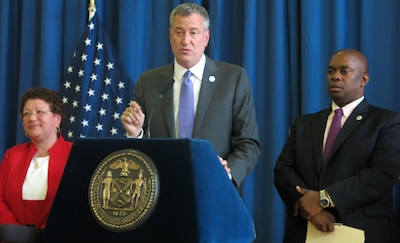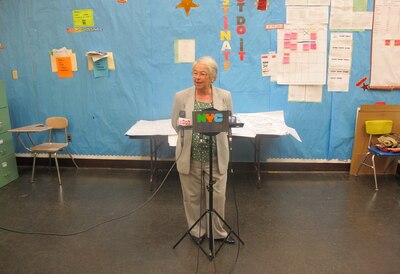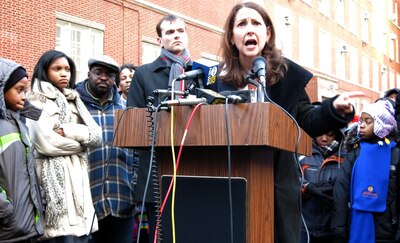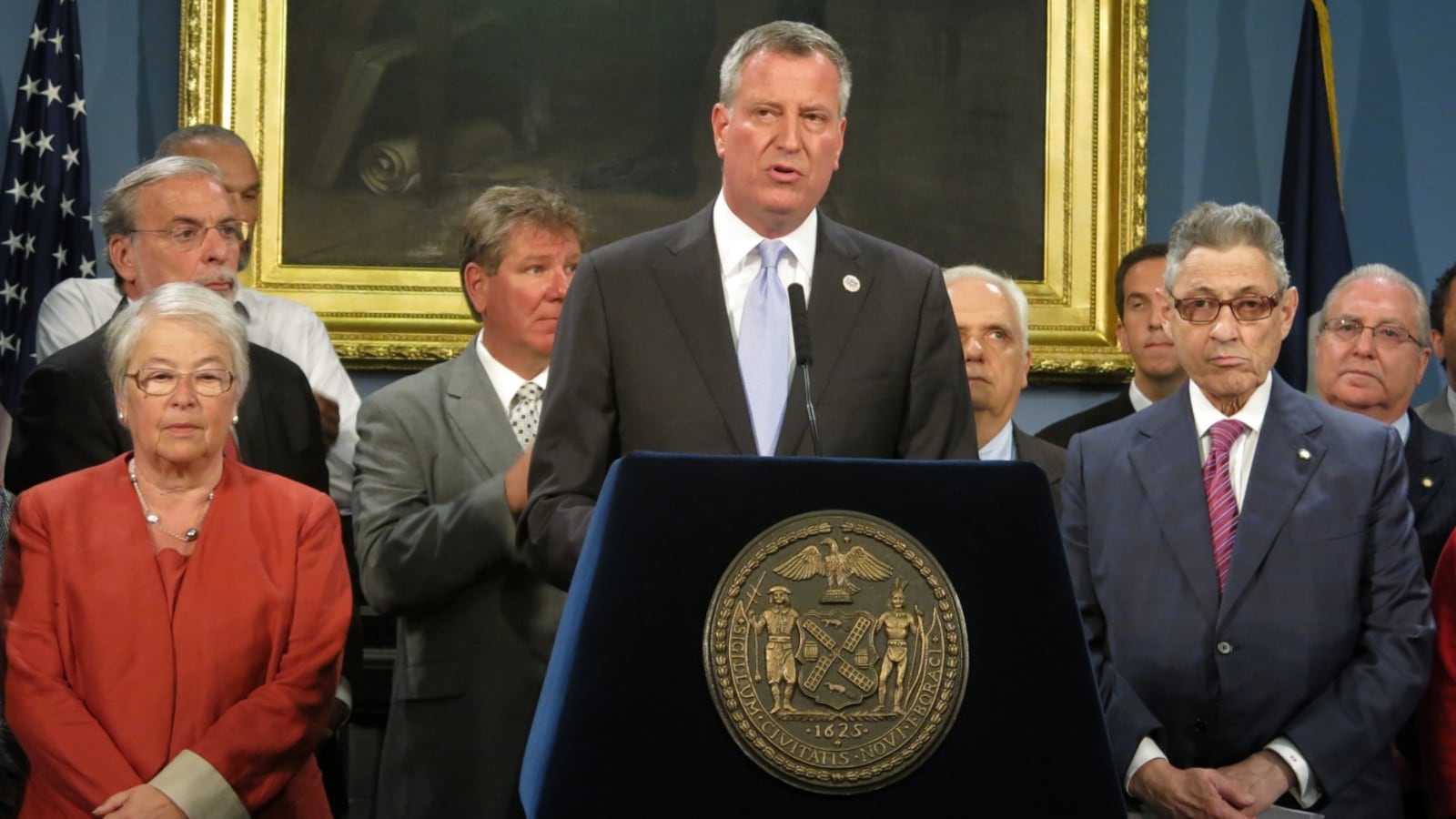Six months ago, Bill de Blasio took control of the largest school district in the country. At the end of his first semester, here’s a recap of what he said he was going to do with it—and what he and Chancellor Fariña have done so far.
[Jump to: new initiatives — accountability — leadership — charter schools — community involvement — teachers and principals]
New or expanded initiatives
Funding an expanded pre-kindergarten program
- On the campaign trail: De Blasio’s plan was

- to dramatically expand pre-kindergarten access by increasing taxes for New Yorkers who earned more than $500,000 a year.
- It happened, though not the way de Blasio wanted. So far, de Blasio has created 45,000 of the 53,000 promised pre-k seats for the 2014-15 school year. He plans to add approximately 20,000 more seats the following year to create enough spots for every four-year-old in the city. The state will provide $300 million for this year’s pre-K expansion.
Creating more community schools
- On the campaign trail: De Blasio committed to creating 100 new community schools that could offer medical and social services, art and fitness programs, tutoring and more to students and their families.
- Some progress. The city announced plans to turn 40 schools into community hubs in June. The plan will cost $52 million in state funding and will play out over the next few years. De Blasio said the schools’ success would be measured by improvements in student health, attendance, and parent engagement as opposed to solely test scores.
Creating new after-school programs
- On the campaign trail: De Blasio’s platform called for after-school programs to be made available to every middle school student in the city.
- It’s in progress, though it’s not being funded the way de Blasio wanted and falls short of the goal he set since taking office. His budget allocated $145 million, as opposed to the $190 million he’d hoped to secure by raising the income tax for the city’s wealthiest residents, allowing for 34,000 new after-school slots. The city would still need to create 16,000 more seats to reach de Blasio’s goal of 95,000 after-school slots by September. The city also secured $7.6 million from the state to extend the school day for 5,000 kids, though those programs aren’t restricted to after-school hours.
Improving special education services
- On the campaign trail: De Blasio noted the low graduation rates for special education students, and said he would strengthen teacher training, “balance” their enrollment across schools, and improve the computer system for keeping track of their information, known as SESIS, and improve bus service.
- The administration has acknowledged the transportation issues, and announced that it will will curb its legal challenges against parents who want the city to pay for their children with disabilities to attend private schools. No other specific news yet.
Improving English language learner services
- On the campaign trail: De Blasio noted “effective programs that can serve as a model for a citywide” and said supports should include more learning time, parent engagement and better teacher training.
- Fariña has talked about needed improvements for the city’s ELL population, but she has not announced specific changes. The state is expected to change regulations for ELL students for the first time in 30 years to offer them more classroom support, and Fariña has pledged to expand billingual program offerings.
Reducing class sizes
- On the campaign trail: “As mayor I would want to be held accountable for reducing class size. If in four years we don’t decrease class size, we’re making a huge mistake.” His platform calls for a class-size-reduction plan for early grades, but doesn’t make specific commitments.
- Not much yet. In Fariña’s “100 days” speech, she said, “To ease the burden on educators, we will work to reduce class size.” Officials have said that additional money from the Campaign for Fiscal Equity lawsuit and said they will allocate $490 million from the Smart Schools Bond Act (assuming it is passed in November) to reduce class sizes. But advocates point out that their capital plan doesn’t keep pace with expected population growth.
Expanding career and technical education
- On the campaign trail: De Blasio promised to expand the city’s network of Career and Technical Education high schools and look for businesses willing to partner with those schools. Specifically, he called for a public safety-themed school to prepare students for police careers.
- Some progress. The city won funding in April for two more 9-14 high schools. Three Career and Technical Education high schools are opening in fall 2014, along with three schools that follow a grades 9-14 model and focus on college and career preparation.
Changing specialized high school admissions
- On the campaign trail: “The notion that children’s futures are determined by a single test and the outcome of that is a series of schools that don’t represent the full population of this city — I don’t know why that alone didn’t say to the people of this city that the overreliance of standardized testing was absolutely bankrupt.”
- No changes yet, including at the five schools for which the city can change the admissions policies without permission from the state legislature. But de Blasio has continued to criticize the admissions requirements, and Fariña has thrown her support behind a bill in the state legislature that would require schools to consider multiple measures, including state test scores and attendance. They have formed a task force of principals to consider new policies.
Changing school safety and discipline policies
- On the campaign trail: “I wouldn’t necessarily change the jurisdiction of the school safety agents away from the NYPD, but I would change the way decisions are made in the school.”
- No changes yet, though an official has thrown support behind a significant expansion of restorative justice programs, for which Fariña has also voiced support. Following the stabbing death of a middle school student, Fariña encouraged principals to establish proactive policies for dealing with bullying, but the city has not indicated plans to strengthen requirements around reporting bullying incidents.
Providing dedicated arts funding for schools
- On the campaign trail: De Blasio said the city should provide it “through the after school program we’ll create by taxing the wealthy.” His platform set a four-year goal for making sure all students were receiving state-mandated arts instruction.
- Some progress. The city set aside $23 million to fund additional arts in schools, though it’s unclear what that will be spent on. Chancellor Fariña has said she will emphasize the arts in a revamped quality review process for schools. After-school programs are getting a big boost, too.
Accountability

Reducing the emphasis on standardized testing
- On the campaign trail: “I would put the standardized testing machine in reverse. It is poisoning our system.” His platform included commitments to eliminate single-test admissions for gifted and talented programs and specialized high schools and increase the use of portfolio assessments in schools.
- Some follow-through and one full reversal. Partially in response to state law changes, the city has broadened the criteria for grade promotion, which has been dependent on state exam scores, and created new rules under which state scores can’t be the main factor used in admissions decisions to selective middle and high schools. But Fariña has vowed to continue the current gifted and talented testing system. State tests aren’t going anywhere, though the department has said it will review the “field tests” used to try out new test questions.
Giving schools A-F letter grades
- On the campaign trail: De Blasio said the letter grades should be done away with, but said overall progress reports should remain available to the public.
- There are signs of movement. Department of Education officials have been meeting with experts to discuss ways to revamp the school Progress Reports, which have until now featured overall school letter grades. In the newly released high school directory, the letter grades are gone and new measures have appeared, such as the percentage of students who are on track after ninth grade or who are satisfied with the school. “I still don’t know what your school report card is,” Fariña told educators at an event celebrating a program celebrating her signature Learning Partners program. “I never checked because I don’t care.”
Reducing school closures
- On the campaign trail: “To too many people over at the Tweed building, closing a school is a panacea. They think it will solve all our problems.”
- The “moratorium” is in effect—but for how long? No new closures were initiated this year, but that’s no surprise since the Bloomberg administration decided not to begin any last-minute closures it wouldn’t be around to carry out. More recently, de Blasio said that once the city has a new plan in place for propping up troubled schools, if a school still doesn’t improve “in a reasonable timeframe,” then the city will consider closure.
Improving struggling schools
- On the campaign trail: De Blasio called for an early-warning system to spot troubled schools, a special Department of Education office to devise intervention strategies, and a “Strategic Staffing Initiative” where a seasoned principal and a team of experienced educators would be deployed to schools that need new leadership.
- Some ideas for improving all schools, but no word about the most troubled schools. Fariña has implemented a plan to get educators to visit schools that have successful strategies to share, and the new teachers contract builds in new time for training and planning. But beyond a program to bring new support services to schools with attendance problems, the city has yet to say how it will intervene in the lowest-performing schools, where more training and resources may not be enough to turn things around.
Changing the support structure for schools
- On the campaign trail: “Districts matter. … We need to find a way to get parents to be able to talk to someone at the district level; teachers, parents relating to leadership at the district level again.”
- No news yet, but subtle signs. Fariña has hinted that she too is unsatisfied with the system of school-support networks, has appointed a top deputy to review the system, but made clear that change won’t come before next year. Still, the city has agreed to create committees within each of the 32 geographic districts to review ways to reduce unnecessary paperwork for teachers.

Leadership
Choosing a chancellor
- On the campaign trail: “Definitely an educator.”
- That happened. Fariña is a former teacher, principal, district superintendent, regional superintendent, and deputy chancellor.
Appointing Panel for Educational Policy members
- On the campaign trail: De Blasio said the mayor should appoint the majority of members, but that they should serve fixed terms so that they have “freedom to actually speak their mind.”
- De Blasio did appoint the majority of members, though it’s unclear whether they have been appointed to fixed terms.
Recruiting and support principals
- On the campaign trail: De Blasio called on improvements to principal recruitment and training. He said leaders need “to have a demonstrated track record” before getting promoted and, to better support rookie principals, suggested scaling up programs run by New Visions and Baruch College.
- One of Fariña’s first moves as chancellor was instituting a requirement that seven years of experience was needed to become a principal. She also hosted a conference for principals with three or fewer years of experience. The de Blasio administration has not made any other announcements about principal training.
Charter schools
Giving charter schools free space in public buildings

- On the campaign trail: “There is no way in hell that Eva Moskowitz should get free rent, OK? There are charters that are much, much better endowed in terms of resources than the public sector ever hoped to be. It is insult to injury to give them free rent.”
- That didn’t work out. Before de Blasio even had a chance to follow through on his pledge to charge rent to charter schools, the state legislature banned it and, in fact, required de Blasio to pay for the space of any new charter. And when de Blasio tried to kick out three of Moskowitz’s schools from public school space, he was sued and quickly found space for her in a private building. He even agreed to pay their rent and will have to fork over $5.4 million next year.
Expanding the city’s charter sector
- On the campaign trail: “We don’t need new charters.”
- The mayor is about to get a lot of new charters, whether he wants them or not (though he never had control over their creation to begin with). He’s moderated his stance on charter schools in a general sense, though he and Fariña have given no indications that they will go out of their way to support the sector’s rapid expansion.
Community involvement
Getting parents more involved in schools

- On the campaign trail: De Blasio played up his role as a public school parent, said he would live-stream important meetings to provide more options for participation, and that he would increase parent involvement in co-location decisions.
- One major change: the new teachers contract builds in time for teachers to reach out to parents. From her second week on the job, Fariña has emphasized parent involvement as one of her key concerns and she was the keynote speaker at two department-hosted conferences for parents. The city has yet to unveil a new process for making school space decisions, one area in which parents advocates have said the community needs a stronger voice.
Improving school space allocation
- On the campaign trail: De Blasio called for “increasing parental engagement and communication in the co-location process.” In particular, he called on paying more attention to students with disabilities and improving how the city responds to community feedback.
- Some movement. City Hall created two working groups: a Blue Book working group to study and revise the city’s space-planning methods and another that will look at the city’s space-crunch issues and determine how schools can better cohabitate. Their recommendations haven’t been made public yet, and neither has a new process for determining where charter schools can be co-located. De Blasio has, however, stood firm on prioritizing students with disabilities in co-location disputes.
Empowering Community Education Councils
- On the campaign trail: De Blasio said he would give them a greater voice in school-space decisions and wanted their meetings streamed online.
- Empowerment apparently starts with accountability. Fariña wants to know how often current members of the elected bodies show up to meetings, and she has the authority to replace those who are chronically truant. But members haven’t actually been given any new power.
Teachers and principals
Evaluating teachers and principals

- On the campaign trail: “The new system is a tremendous improvement over the past,” de Blasio said. “I remain concerned about the extent to which scores on state tests will factor into teacher evaluations and believe we need to watch closely how the pilot use of student surveys to rate teachers plays out in our schools.”
- Some changes, within his power. During contract negotiations with the UFT, the city agreed to set up a new appeal process for teachers whose evaluation ratings are based, at least in part, on test scores from subjects and students they don’t teach. He also delayed the rollout of the student survey component of the evaluation plans by at least one year. The state has reached its own agreement to reduce the effects of state test scores for this year and next year.
Retaining more teachers
- On the campaign trail: “The city needs to encourage New Yorkers to consider teaching as a profession by expanding ‘grow your own’ programs in high schools, teacher residency programs, and partnerships with CUNY and SUNY colleges.” His platform called for the creation of career paths like “Lead Teachers” and “Master Teachers” to encourage retention.
- Halfway there. De Blasio followed through by creating three teacher leadership positions, with higher pay and more responsibility, which were negotiated into the city’s new contract with the United Federation of Teachers. The administration is also funding a $6.7 million Teaching Fellows-inspired partnership with CUNY that would train and certify 400 pre-K teachers by September 2015. But the program is aimed more at building teacher capacity at the pre-K level than at increasing retention.
Supporting ‘last in, first out’ teacher protections
- As public advocate: “Look, my two kids are in public school and part of my objection here also is that there are good and bad teachers that are newcomers and there are good and bad teachers that are veterans … it’s a mixed bag. Those who don’t teach well over a period of time need to leave.”
- No specific word. When discussing a lawsuit that could challenge job protection laws for teachers in New York, de Blasio has not specifically talked about seniority laws that protect veteran teachers during layoffs. He has defended tenure and said the state’s teacher evaluation system makes the lawsuit unnecessary.


